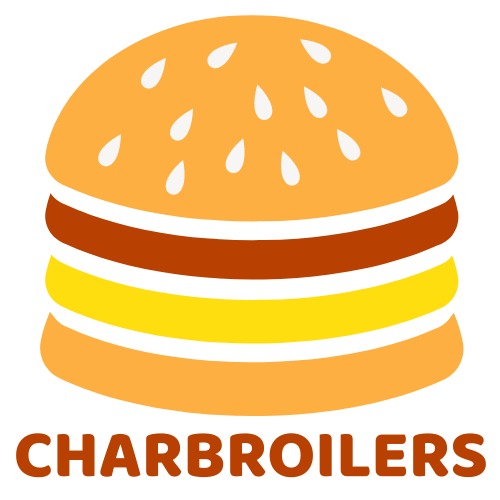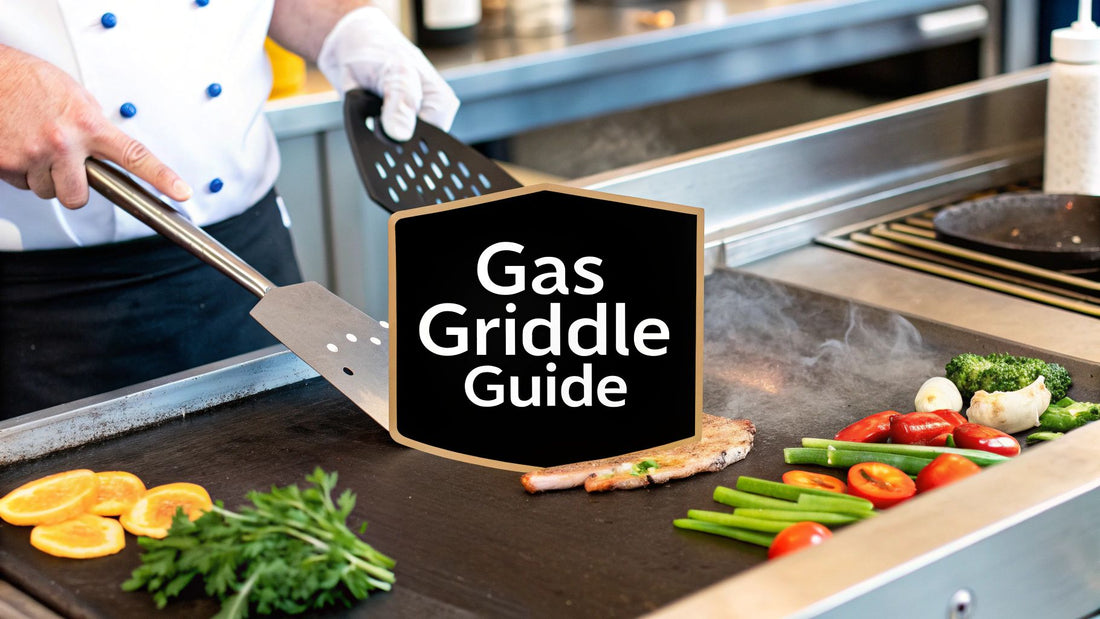
Choosing Your Commercial Gas Griddle
Share
Picture this: one single piece of equipment that can power you through the breakfast rush, crush the lunch crowd, and still handle dinner service without breaking a sweat. That’s a commercial gas griddle. It’s less of an appliance and more like the tireless engine of your kitchen, churning out everything from perfect pancakes to flawlessly seared burgers. It is, without a doubt, the versatile workhorse that forms the backbone of countless successful kitchens.
Why a Griddle Is Your Kitchen's Most Valuable Player
In any high-volume kitchen, efficiency and consistency are the names of the game. A commercial gas griddle is a strategic investment precisely because it delivers on both fronts. Think of it as the most versatile player on your culinary team—the one you can put in any position and know it'll get the job done, from morning 'til night.
During a chaotic breakfast service, its huge, flat surface can be cooking dozens of eggs, pancakes, and bacon strips all at once. When the menu flips to lunch, that same surface is searing burger patties, toasting buns, and sautéing vegetables to perfection. This incredible adaptability makes it an essential tool for expanding your menu without cluttering up the cook line with single-purpose gear.
The Power and Precision of Gas
The real magic of a gas griddle lies in its raw power and responsiveness. Electric models can be sluggish, taking their time to recover when you slap a bunch of cold food on them. A commercial gas griddle, on the other hand, gives you instant heat and lets your chefs make rapid temperature adjustments on the fly. That kind of control is absolutely critical when the pace is relentless during peak hours.
Here's what that gas power gets you:
- Rapid Heat-Up: Gas burners get the griddle plate hot and ready to cook in a fraction of the time, cutting down on wasted minutes at the start of a shift.
- Quick Temperature Recovery: When cold food hits the surface, a powerful gas griddle snaps back to its set temperature almost instantly. This is key for consistent cooking and preventing food from getting greasy or soggy.
- Precise Control: Chefs can visually adjust the flame, giving them an intuitive feel for the heat. It’s a level of hands-on control many pros swear by for everything from a hard sear to delicate cooking.
This combination of speed and control is what empowers your kitchen staff to hold the line on quality and ticket times, even when the dining room is packed.
A Cornerstone of the Modern Kitchen
You don't have to just take my word for it; the market numbers tell the same story. The global commercial griddle market was valued at a whopping USD 1.96 billion and is expected to climb to USD 3.12 billion by 2033. While electric models have their place, the commercial gas griddle remains a favorite in busy hotels, bars, and restaurants for its unbeatable heat-up speed and temperature stability—two things you just can't compromise on. If you're a numbers person, you can dig into these market trends over at Business Research Insights.
A well-chosen griddle isn't just a piece of metal; it’s a promise of consistency. It ensures the first pancake of the day is cooked just as perfectly as the last burger of the night, building the kind of customer trust that pays the bills.
When you start seeing the griddle as a strategic asset, your whole perspective shifts. It’s not just about cooking food anymore. It's about unlocking menu versatility, streamlining your entire workflow, and cranking out consistently great food that keeps people coming back. It’s the quiet hero of the kitchen line.
Getting to Know Your Griddle's Anatomy
To really get the most out of a commercial gas griddle, you’ve got to pop the hood and see what makes it tick. Its performance isn't some kind of kitchen magic—it's the direct result of how well its core parts work together. Knowing this anatomy is what separates a true kitchen workhorse from a cheaper model that's going to buckle under pressure.
Let's break down the four critical pieces that dictate how your griddle performs in a busy kitchen: the griddle plate, the burners, the controls, and the grease management system. Each one has a huge job to do in delivering the consistent, high-quality results your menu and your customers demand.
The Griddle Plate: The Foundation of Performance
This is where all the action happens. The best way to think about the griddle plate is like the foundation of a house. A flimsy foundation is going to compromise everything you build on it, right? It's the same with a thin griddle plate—it’ll heat up fast, sure, but it will lose that heat just as quickly. That leads to frustrating hot spots and painfully slow recovery times when you drop a dozen cold burger patties on it.
A thicker, heavier plate—we’re talking 3/4-inch to 1-inch thick—is your best friend in a high-volume kitchen. It acts like a thermal battery, soaking up a massive amount of heat and spreading it evenly across the entire surface. This incredible heat retention means it can handle back-to-back orders without big temperature drops, ensuring every pancake, steak, or hash brown is cooked with perfect consistency. If you're looking at different sizes, you can get a great breakdown in this 48-inch commercial flat top grill guide.
Burners: The Engine of Your Griddle
If the plate is the foundation, then the burners are the engine. They're responsible for delivering the raw power (measured in BTUs) needed to get that heavy steel plate up to temperature. The way these burners are designed directly impacts how evenly that heat gets distributed.
You'll generally run into two common types:
- U-Shaped Burners: These are a popular and very reliable choice. Placed about every 12 inches, their U-shape helps spread the flame and heat over a much wider area than a simple straight burner, which goes a long way in reducing those annoying hot and cold zones.
- Infrared Burners: This tech uses a special ceramic plate to generate intense, radiant heat. Infrared systems are absolute beasts when it comes to fast preheating and create a powerful, uniform cooking surface.
No matter which type you go with, the goal is always the same: even heating. An underpowered griddle or one with poorly designed burners will have your cooks doing the "griddle shuffle"—constantly moving food around to find the good spots. That slows down your whole line.
Controls and Grease Management
The controls are how you talk to the griddle. You’ll typically choose between simple manual controls (think low-to-high settings) and thermostatic controls, which let you dial in a precise temperature and hold it there. I'll get into a full comparison later in our FAQ section to help you decide which is right for you.
Finally, a smart grease management system is completely non-negotiable for safety and cleanliness. This system is made up of a grease trough and a collection tray. A well-designed trough will efficiently channel grease away from the cooking surface, preventing dangerous flare-ups and stopping your food from getting greasy. An easy-to-remove, large-capacity grease tray makes end-of-night cleanup way faster and simpler for your staff.
Understanding these components empowers you to evaluate a commercial gas griddle based on its engineering and build quality, not just its price tag. This knowledge ensures you select a model truly built for peak performance in a professional kitchen.
How to Select the Right Commercial Gas Griddle
Picking the right commercial gas griddle is about much more than just finding one that fits on your line. It’s a strategic decision. Get it right, and you’ll improve your kitchen’s entire workflow, expand your menu, and deliver consistently delicious food. Get it wrong, and you'll be fighting your equipment during every single service.
Let’s walk through what really matters. We’ll look at sizing it up for your real-world volume, picking the right cooking surface for your menu, and choosing the controls that will make your chefs’ lives easier. A smart choice here will pay you back every time you fire it up.
Matching Griddle Size to Your Kitchen Volume
First things first: size. Think of your griddle surface like a highway during rush hour. Too small, and you get traffic jams that slow down the whole kitchen. The trick is to find that sweet spot—enough cooking space to crush your busiest hours without wasting energy or precious line space.
To nail down the right dimensions, look at your menu and your peak service times. A classic diner flipping hundreds of pancakes for the breakfast rush needs a much bigger griddle than a fine-dining spot that just sears a few portions of fish for dinner service.
A good rule of thumb is to look for at least 12 inches of griddle width for every 25,000 to 30,000 BTUs of power. This ensures the griddle has enough horsepower to maintain consistent heat across the entire surface, even when it’s loaded with food.
Plate Surface: Standard Steel vs. Non-Porous Chrome
Once you've got your size figured out, the next big decision is the griddle plate itself. This choice has a huge impact on everything from how your food tastes to how much time your crew spends cleaning at the end of the night.
- Standard Steel Plate: This is the tried-and-true workhorse of the industry. Steel is a fantastic heat conductor, and once you get it properly seasoned, it develops a beautiful, naturally non-stick surface. It’s tough and perfect for getting that classic griddle flavor, but it needs consistent care to prevent sticking and rust.
- Chrome Plate: A chrome-plated griddle gives you a slick, non-porous surface that looks like a mirror. The biggest advantage here is zero flavor transfer. You can cook fish, wipe it down, and immediately cook eggs without any funky taste crossover. Chrome also radiates less heat into the kitchen, which is a nice bonus. The downside? It's more delicate and can be scratched by metal spatulas.
This image breaks down some of the key parts you'll want to pay attention to.
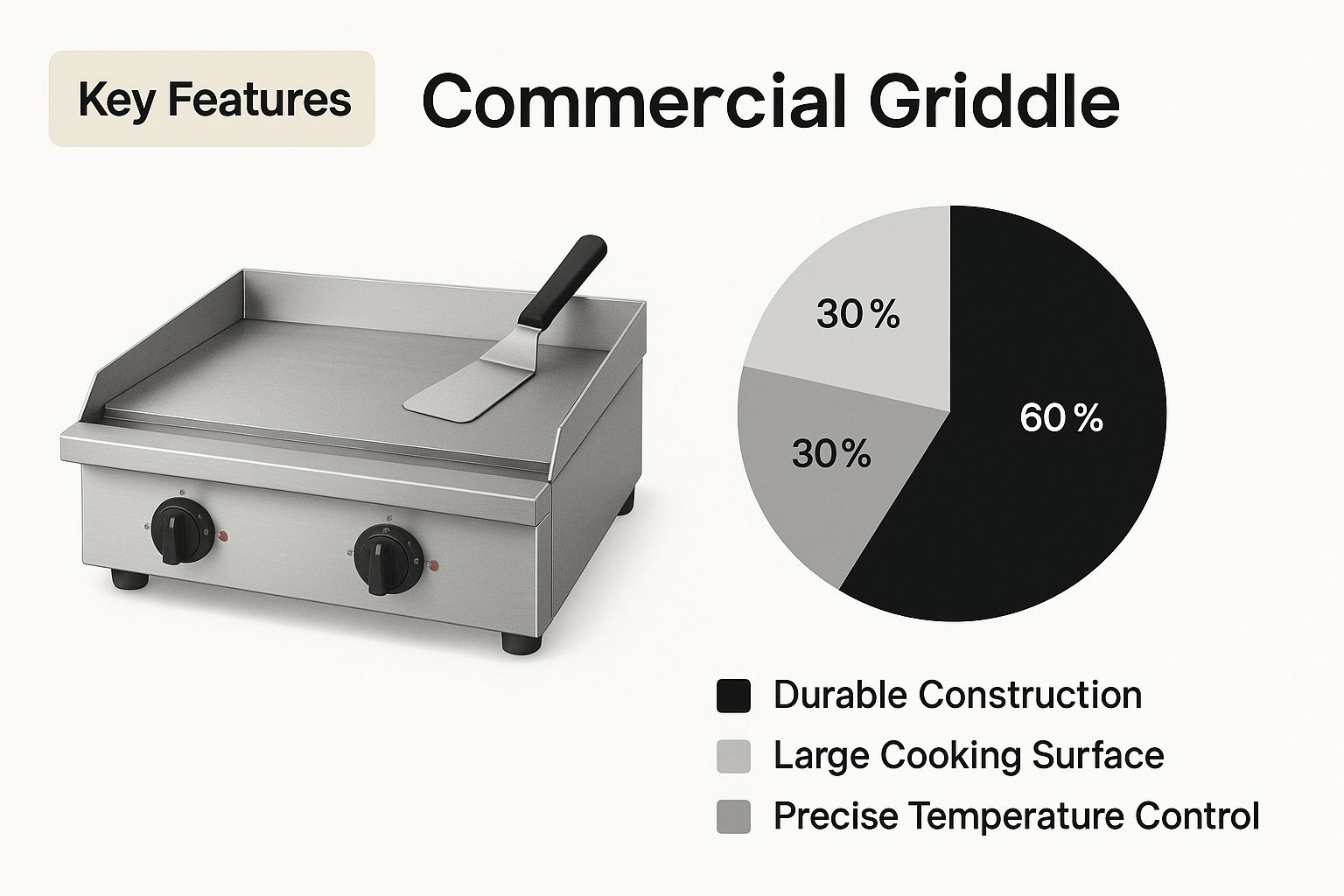
Understanding these components is what separates a smart purchase from a costly mistake.
To help you visualize the differences, here's a quick comparison of the features we've discussed so far.
Commercial Gas Griddle Feature Comparison
| Feature | Standard Steel Plate | Chrome Plate | Thermostatic Controls | Manual Controls |
|---|---|---|---|---|
| Heat Transfer | Excellent, even heating | Good, but more radiant | Maintains precise temperature | Operator-managed heat levels |
| Flavor Transfer | Can occur if not cleaned well | Minimal to none | N/A | N/A |
| Cleaning | Requires seasoning and scraping | Wipes clean easily | N/A | N/A |
| Durability | Very durable, resists scratches | Prone to scratching with metal tools | N/A | N/A |
| Best For | Diners, high-volume breakfast | Delicate foods (fish, eggs), show kitchens | Consistency, less experienced staff | Experienced chefs, fast-paced work |
This table should make it easier to see how each feature lines up with what you actually need in your kitchen.
Manual vs. Thermostatic Controls
Finally, you need to decide how you want to control the heat. This choice usually boils down to your menu's demands and the skill level of your kitchen crew.
- Manual Controls: These are your basic low, medium, and high knobs. Old-school chefs often swear by them because they're simple, responsive, and give them a direct feel for the heat. They can make quick adjustments on the fly. For a deep dive into some great models with this setup, check out our guide on the top commercial griddle propane picks that sizzle.
- Thermostatic Controls: This is the "set it and forget it" option. You dial in an exact temperature—say, 350°F—and the griddle’s internal thermostat cycles the burners on and off to hold that temp. It's fantastic for consistency, especially with delicate items or in kitchens where you might have newer cooks on the line. It just takes the guesswork out of the equation.
By thinking through the size you need, the plate material that fits your menu, and the control type that suits your team, you can land on a commercial gas griddle that will be a profitable workhorse in your kitchen for years to come.
Mastering Daily Griddle Care and Maintenance
A commercial gas griddle is a long-term investment. Like any valuable piece of kitchen equipment, its performance and lifespan depend entirely on how well you treat it. This isn't just about wiping it down; it's about protecting your investment, guaranteeing food safety, and making sure every dish that comes off that flat-top is cooked to perfection.
By turning a few key practices into daily habits, your kitchen staff can keep your griddle running like the reliable, high-performing workhorse it's meant to be for years.
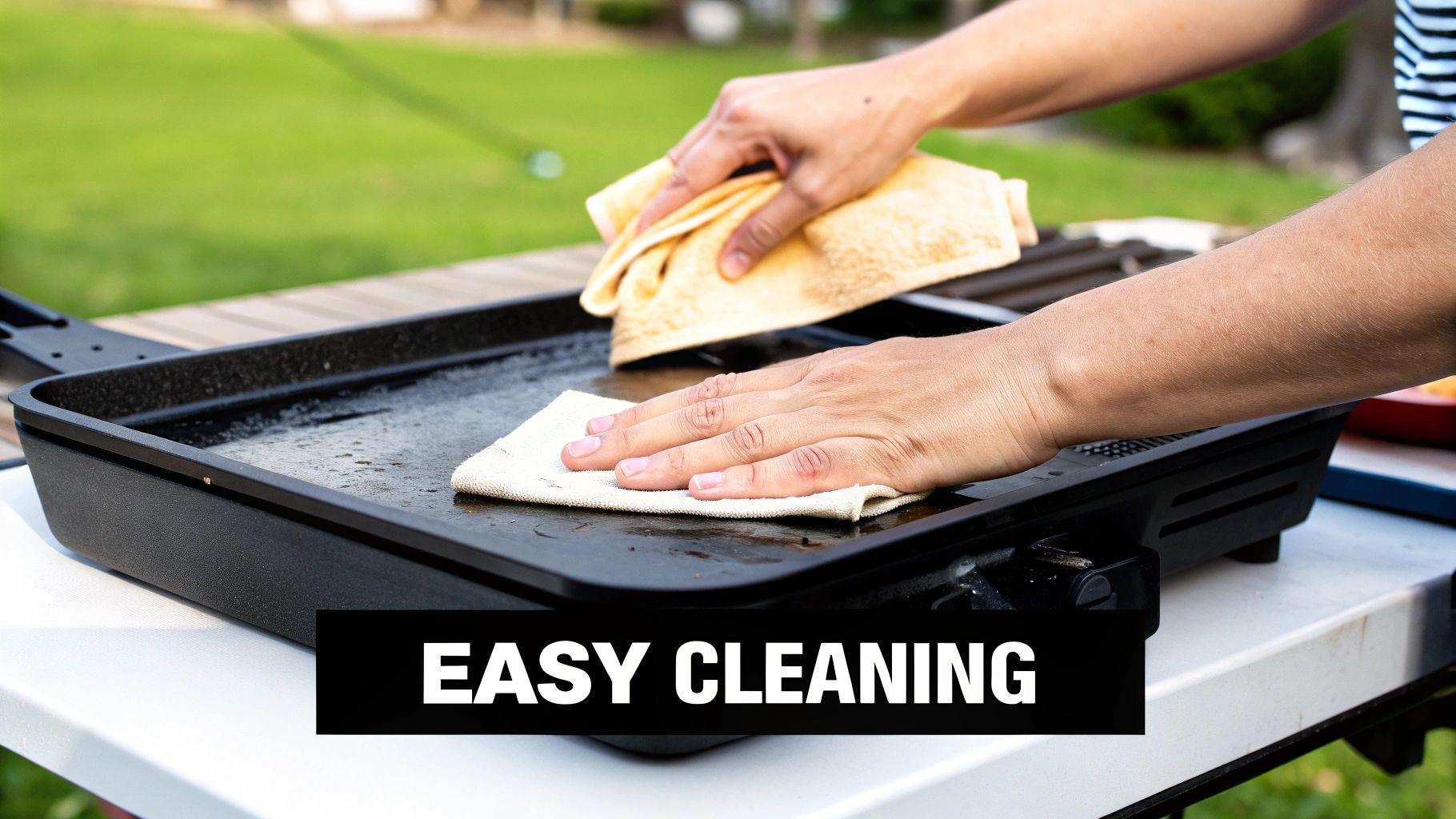
Think of this section as your complete playbook for griddle maintenance. We’ll walk through everything from that crucial first seasoning to daily cleaning routines and simple preventative checks that make all the difference.
The Art of Seasoning Your Griddle Plate
Before you even think about cooking a single pancake, a new steel griddle plate needs to be seasoned. Think of it like creating a natural, non-stick shield for the cooking surface—a slick, protective layer that gets better with every single use.
Good seasoning does a few critical things: it stops food from sticking, protects the raw steel from rust, and helps build up that classic, rich flavor that only a well-loved griddle can deliver.
Here’s a simple, step-by-step process to get it right:
- Clean the New Surface: First things first, wash the new griddle plate with warm, soapy water. This removes any factory coatings or shipping debris. Rinse it well and dry it completely.
- Apply Oil: Pour a little bit of high-smoke-point oil (canola or vegetable oil works great) onto the surface. Use a clean, lint-free cloth to spread a very thin, even layer across the entire plate.
- Heat It Up: Fire up the griddle to a medium-high heat, somewhere around 350-400°F. Let the oil heat until it starts to smoke slightly. That smoke is the sign that the oil is bonding with the steel.
- Cool and Repeat: Turn the griddle off and let it cool down. Wipe off any excess oil, and then repeat the process two or three more times. This builds a solid, slick, and durable base layer that's ready for action.
Daily Cleaning Your Griddle
Maintaining that perfect cooking surface requires a non-negotiable cleaning routine. A dirty griddle is a kitchen liability. Leftover grease can cause dangerous flare-ups, and those little carbonized food bits will transfer burnt, nasty flavors to your fresh food. A clean griddle, on the other hand, means even cooking and safe food.
The trick is to clean it while it’s still warm. This makes scraping off food residue and grease a whole lot easier.
- Scrape It Down: While the griddle is still hot, use a heavy-duty bench scraper or griddle scraper. Push all the food debris and excess grease directly into the grease trap.
- Use a Griddle Brick: For tougher, baked-on grime, a griddle brick or pumice stone works wonders. Apply gentle but firm pressure and move in the direction of the metal’s grain to scrub the surface clean without gouging it.
- Final Wipe-Down: Once the surface is smooth, use a cloth with a tiny amount of clean cooking oil to wipe it down. This light coating protects the steel from moisture and rust overnight, leaving it perfectly prepped for the next shift.
For a deeper dive into this process, check out our ultimate guide to cleaning a commercial stainless steel griddle.
A well-cared-for griddle is the cornerstone of kitchen efficiency. Proactive maintenance prevents the costly downtime and inconsistent results that come from neglected equipment, ensuring your kitchen runs smoothly shift after shift.
Essential Preventative Maintenance Checks
Beyond the daily scrub-down, a few regular checks can stop major problems before they start. These quick inspections help you catch minor issues before they turn into expensive repairs or serious safety hazards.
Regular Maintenance Checklist
- Gas Line and Hose Inspection: Once a week, take a close look at the gas hoses. You're searching for any cracks, kinks, or signs of wear and tear. This simple check is crucial for preventing dangerous gas leaks.
- Thermostat Calibration: If your griddle has thermostatic controls, you need to periodically check their accuracy with an infrared thermometer. An uncalibrated thermostat leads to undercooked or burnt food. Make sure the temperature you set is the temperature you're actually getting.
- Grease Trap Management: This is a big one. The grease trap must be emptied after every single shift. Letting it overflow is a massive fire hazard and a sanitation nightmare waiting to happen.
By making these practices a non-negotiable part of your kitchen's routine, you ensure your commercial gas griddle remains a safe, dependable, and profitable asset for years to come.
Taking Your Griddle Skills to the Next Level
Once you’ve got the daily grind of your commercial gas griddle down, it's time for the fun part. This is where you move beyond just being an operator and start becoming a true griddle master. A simple flat top can do so much more than flip burgers and cook eggs; in the right hands, it’s an instrument for culinary creativity.
This section is for the chefs who want to push what's possible. We're going to get into pro-level strategies like zone cooking and the real science behind creating unbelievable flavor. Let's see how this one piece of equipment can elevate your entire kitchen's game.
Mastering Zone Cooking on Your Griddle
One of the most powerful techniques in any seasoned chef's toolkit is zone cooking. It’s a simple but brilliant idea: create different temperature zones across your single griddle surface. Think of it like having three or four pans on a stove, each at a different heat, but all on one big, seamless cooktop.
For griddles with multiple burner controls, this is a game-changer. You can set one end to high heat for a killer sear, the middle section to a steady medium for cooking things through, and the far end to low for holding or gentle warming.
This method transforms your kitchen's workflow. Imagine this:
- A chef gets a beautiful, hard sear on a thick-cut steak in the high-heat zone.
- At the same time, they're gently toasting brioche buns or sautéing delicate mushrooms in the medium-heat zone, without a hint of burning.
- Once an item is perfectly cooked, it slides over to the low-heat zone, holding at the ideal serving temperature until the rest of the plate is ready to go.
It’s a dynamic way to cook that lets you perfectly time and assemble complex dishes without juggling a half-dozen pans. You end up using every square inch of your griddle surface, making your whole line more efficient.
The Science of the Perfect Sear
Ever wonder what creates that deep, savory, golden-brown crust on a perfectly cooked burger or scallop? It’s not just about high heat—it’s pure chemistry. We're talking about the Maillard reaction. This is the complex process that happens when amino acids and sugars in food hit the heat, creating hundreds of new aroma and flavor compounds.
Your commercial gas griddle is the perfect stage to make this magic happen. To get that exceptional Maillard crust, you need two things: high, stable heat and a dry surface. The heavy steel plate of a gas griddle is a master at storing and blasting the intense thermal energy needed to kick this reaction into high gear, fast. The result is that deep, complex flavor and satisfying texture you just can't get with lower-temperature cooking.
"The true art of griddle cooking lies in controlling heat to create flavor. The Maillard reaction is your primary tool for turning simple ingredients into something deeply savory and memorable for your customers."
Thinking Outside the Box: Unconventional Griddle Uses
Your griddle can do so much more than the usual suspects. Savvy chefs in every kind of kitchen, from bustling diners to high-end bistros, are finding new ways to make their griddles work harder for them.
Creative Griddle Uses
- Flash-Wilting Greens: Need to wilt a huge batch of spinach or kale in a hurry? A hot griddle will get it done in seconds, keeping that vibrant color and great texture way better than steaming ever could.
- Toasting and Grilling Bread: From perfectly golden brioche buns to crispy, grilled paninis, the even, dry heat of a griddle is unbeatable for getting a uniform, delicious result.
- Holding and Finishing Sauces: That low-temperature zone on your griddle is the perfect spot to hold delicate sauces like hollandaise or beurre blanc, keeping them at the perfect consistency without any risk of them breaking.
This kind of versatility is exactly why this equipment is seeing such growth. The global commercial griddle market, valued at around $2.5 billion, is on track to hit about $3.3 billion, with a Compound Annual Growth Rate (CAGR) of roughly 5%. This isn't just a random number; it shows how much the industry values versatile, efficient equipment that can support creative menus. To see more on these trends, you can review the commercial griddle market analysis.
The Perfect Partner: Your Griddle and a Charbroiler
A gas griddle is king when it comes to uniform, direct-contact heat. But some menus demand that distinct, smoky flavor and those iconic grill marks that only open-flame cooking can deliver. This is where a charbroiler becomes your griddle's perfect partner on the line. A charbroiler uses grates to expose food to direct flame, creating that smoky char that’s perfect for steaks, chicken, and some styles of burgers.
For a truly capable kitchen, we offer a wide selection of commercial charbroilers to work alongside your griddle. Our lineup includes powerful gas charbroilers for that classic grill flavor, efficient electric models for precise heat, and advanced infrared charbroilers that deliver an intense, even sear. By pairing these two powerhouse appliances, there’s virtually no cooking technique your menu can throw at you that you can't handle.
Your Commercial Gas Griddle Questions Answered
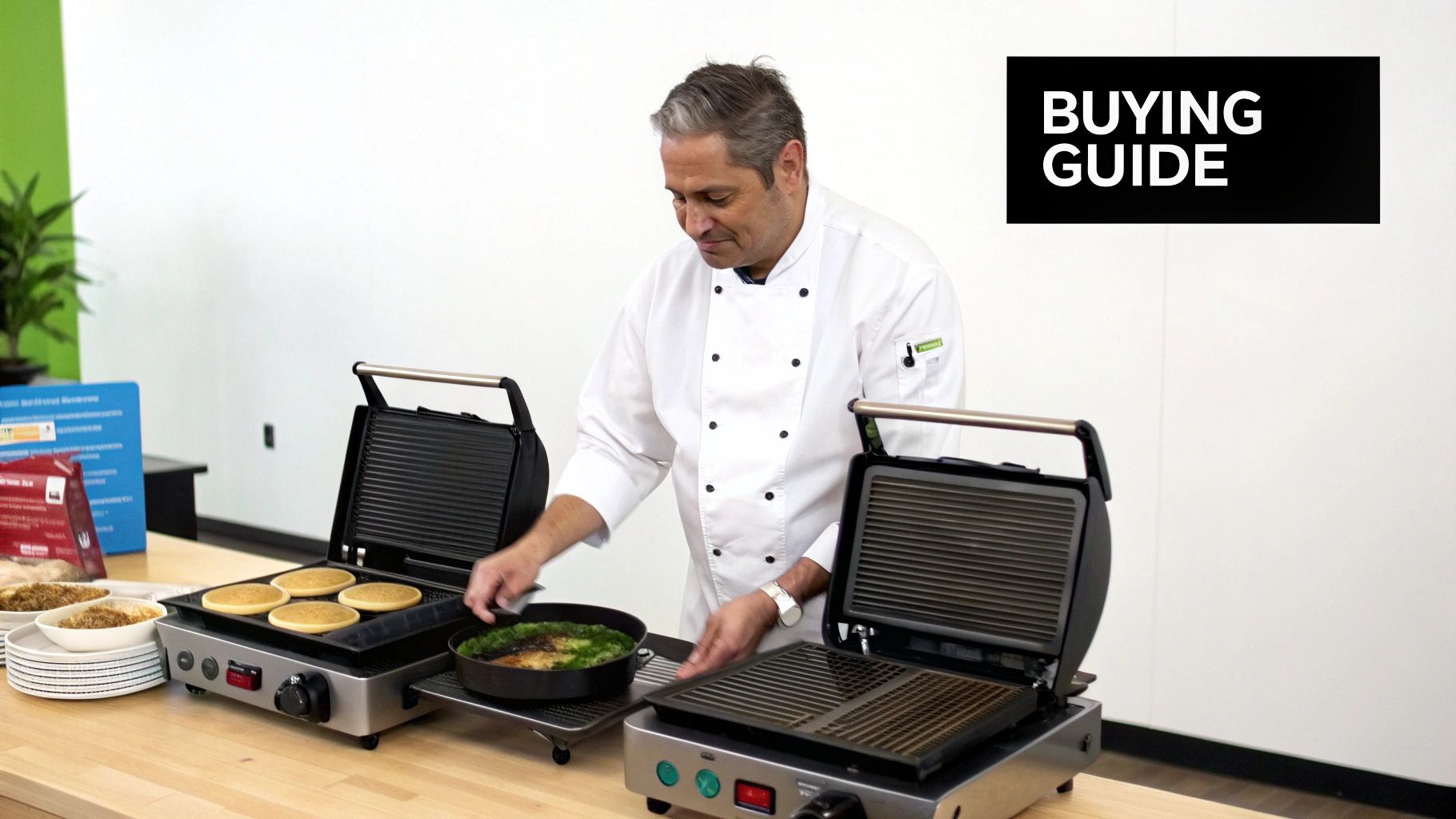
When you're outfitting a professional kitchen, getting the right advice can make all the difference. To help you make a confident choice, we've rounded up the most common questions we hear from chefs and restaurant owners about buying and running a commercial gas griddle. Here are the clear, straightforward answers you've been looking for.
What Is the Difference Between a Griddle and a Charbroiler?
This is one of the first questions any kitchen manager asks when designing a cook line. The main difference comes down to the cooking surface and how heat actually gets to the food.
A commercial gas griddle has a solid, flat metal plate. It cooks with direct, even heat across the whole surface, which is why it's the champion for anything that needs consistent contact—think pancakes, eggs, chopped cheesesteaks, and searing a dozen burger patties at once.
A charbroiler, on the other hand, uses open grates that let food cook directly over the flame. This is how you get those classic grill marks and that distinct smoky flavor you just can't replicate on a flat-top. It's the go-to for steaks, chicken breasts, and burgers where char is part of the appeal. Truthfully, most kitchens need both to really maximize their menu.
For a truly versatile kitchen, pairing a griddle with the right charbroiler is a winning combination. This allows you to handle any cooking style your menu demands, from delicate breakfast items to perfectly charred steaks.
To complete your cooking line, we offer a wide selection of commercial charbroilers to suit any restaurant's needs. You can explore high-performance models including powerful gas charbroilers, precise electric charbroilers, and advanced infrared charbroilers that deliver intense, uniform searing.
Should I Get Thermostatic or Manual Controls?
Your choice here really depends on your menu and the skill level of your kitchen crew. Neither one is automatically "better"—it's all about matching the controls to your operation.
Thermostatic controls are your "set-it-and-forget-it" option. You dial in a specific temperature, and a sensor automatically cycles the burners to hold that heat. This is a huge win for consistency, especially with finicky foods like fish or eggs, and it’s a lifesaver in kitchens with less experienced staff because it takes out the guesswork.
Manual controls, with their familiar "low, medium, high" dials, put the chef in direct command of the flame. Many seasoned chefs love this hands-on feel for its instant response and intuitive nature, especially when they need to crank the heat for a quick sear. The trade-off? Manual controls require constant attention to keep the temperature steady during a busy service.
How Thick Should the Griddle Plate Be?
The thickness of the griddle plate is one of the most critical factors in how it performs. You'll see plates ranging from a thin 1/2-inch to a full 1-inch thick.
For almost any high-volume kitchen, a thicker plate—at least 3/4-inch to 1-inch—is a much better investment. Think of it like a thermal battery. It takes a bit longer to heat up, but once it's hot, it stores a massive amount of heat and distributes it far more evenly across the surface.
This amazing heat retention means it recovers its temperature much faster after you slap down a bunch of cold food. That’s absolutely critical for avoiding slow cook times and uneven results during the dinner rush. A thinner plate heats up fast, but it loses that heat just as quickly, making it a poor choice for constant, heavy use.
Why Do BTUs Matter for a Gas Griddle?
BTU, or British Thermal Unit, is simply a measure of a griddle's heat output—in kitchen terms, its raw power. A higher BTU rating means faster preheating and, more importantly, much better heat recovery.
In a commercial kitchen, you need enough power to keep up with a non-stop flow of tickets without the griddle's temperature dropping off a cliff. An underpowered griddle will struggle to stay hot during your busiest hours, slowing down the entire line and hurting the quality of your food.
As a solid rule of thumb, look for a commercial gas griddle that delivers at least 25,000 to 30,000 BTUs for every 12 inches of width. Always make sure the griddle’s power is matched to your kitchen's real-world volume to keep service running like a well-oiled machine.
Equip your kitchen with the best tools for the job. At Charbroilers, we specialize in high-performance cooking equipment designed for the demands of the modern restaurant. Explore our complete selection of charbroilers, griddles, and more today.
